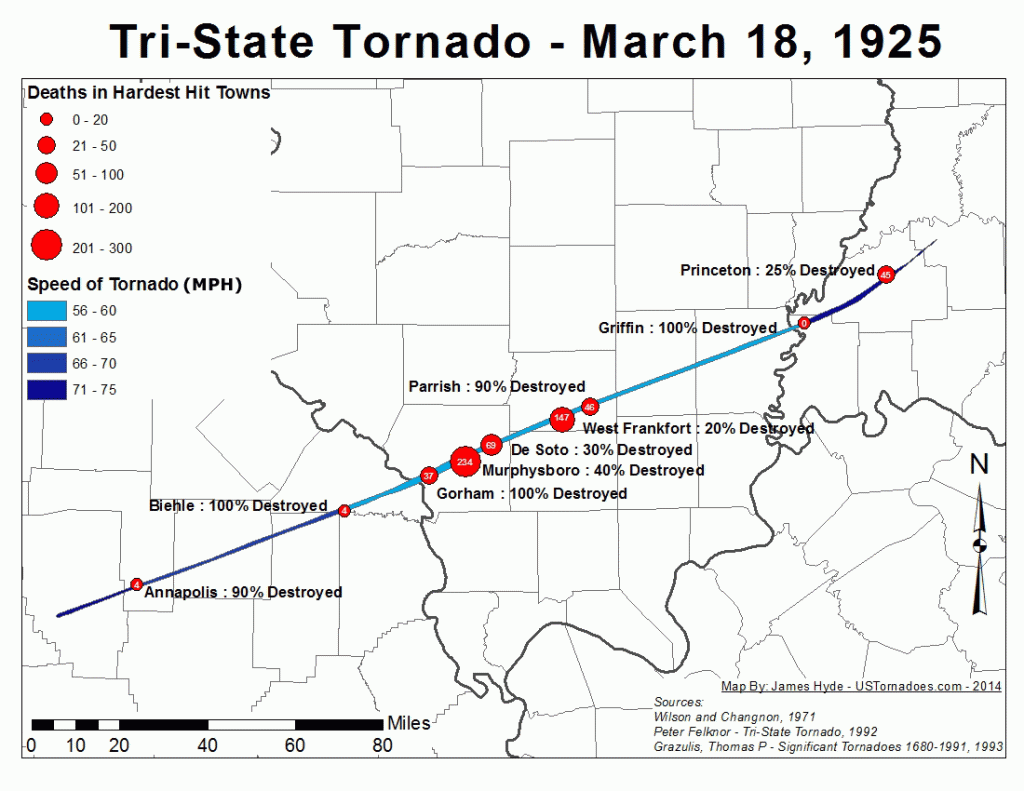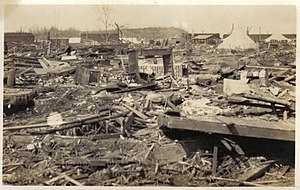The Tri-State Tornado: A Trail of Destruction Across Three States – March 18, 1925
The afternoon of March 18, 1925, etched itself into the annals of American history as the deadliest tornado event the nation has ever witnessed. A single, monstrous tornado tore through portions of Missouri, Illinois, and Indiana, leaving behind a 219-mile path of devastation. In its wake, the Tri-State Tornado, as it came to be known, claimed 695 lives, injured over 2,000 people, and caused catastrophic damage to homes, businesses, and the landscape itself. The roar of the tornado was said to be audible from miles away, described by survivors as sounding like a freight train or the continuous rumble of thunder.
Emerging in southeastern Missouri, the tornado first touched down around 1 p.m. near Ellington. Witnesses reported seeing a dark, swirling funnel cloud descend from the sky, growing in size and intensity as it moved across the countryside. The small community of Annapolis, Missouri was directly in its path, and within minutes, the town was reduced to rubble. Homes were obliterated, trees uprooted, and the local schoolhouse was completely destroyed with over 100 students inside. Miraculously, only one child lost their life due to the quick actions of the teachers who ushered the children into the basement just before the tornado struck. Sadly, 38 people lost their lives in Annapolis alone. Continuing its northeastward track, the tornado crossed the Mississippi River into southern Illinois, striking the towns of Gorham and Murphysboro. Murphysboro suffered the most significant loss of life with 234 fatalities. The business district was completely leveled, and the remains of the Murphysboro High School were scattered for miles.

As the tornado moved into Indiana, its path widened, reaching an astonishing 2.5 miles at its maximum width. The towns of Griffin and Owensville were heavily impacted, with countless homes and businesses leveled. In Griffin, a local church was destroyed while a service was in progress, resulting in the tragic loss of 69 lives. The Tri-State Tornado finally dissipated near Petersburg, Indiana, after a horrifying 3.5-hour rampage. In total, 19 communities were directly affected, with thousands of buildings destroyed and an estimated $17 million in property damage (equivalent to over $250 million today). The aftermath resembled a war zone, with debris strewn across the landscape and survivors left in shock and despair.
The meteorological conditions that spawned the Tri-State Tornado were a potent mix of atmospheric ingredients. A strong low-pressure system tracked across the central plains, dragging a warm front northward. To the south, warm, moist air surged from the Gulf of Mexico, while cold, dry air aloft created an unstable atmosphere. As the warm front collided with the colder air, powerful thunderstorms erupted, providing the energy needed for tornadic development.
The specific dynamics of the storm system, including wind shear (changes in wind speed and direction with height), contributed to the tornado’s longevity and intensity. The wind shear created a horizontal rolling motion in the atmosphere, which helped to concentrate and stretch the storm’s rotation, leading to the formation of a long-lasting and powerful tornado. Additionally, the relatively flat terrain of the region offered little resistance to the twister’s path, allowing it to maintain its strength over a longer distance.

The Tri-State Tornado remains a stark reminder of the destructive power of nature and the importance of severe weather preparedness. Its legacy has contributed to advancements in tornado research, forecasting, and warning systems, ultimately saving countless lives in the decades since this devastating event. The storm’s impact on the field of meteorology is undeniable, as it prompted further study of tornado formation and behavior, leading to improved understanding and prediction of these destructive forces.
One of the closest comparisons in terms of path length is the Great Natchez Tornado of 1840. This devastating tornado, which struck Natchez, Mississippi and surrounding areas, carved a path estimated to be between 150 and 200 miles long. However, due to limitations in record-keeping and population density at the time, the exact number of fatalities remains uncertain, with estimates ranging from 100 to 317 deaths.
Another notable tornado event was the 1974 Super Outbreak, which unleashed 148 tornadoes across 13 states in just 18 hours. This outbreak resulted in 330 fatalities and caused extensive damage. However, the Super Outbreak was characterized by numerous individual tornadoes, rather than a single, long-track event like the Tri-State Tornado.
